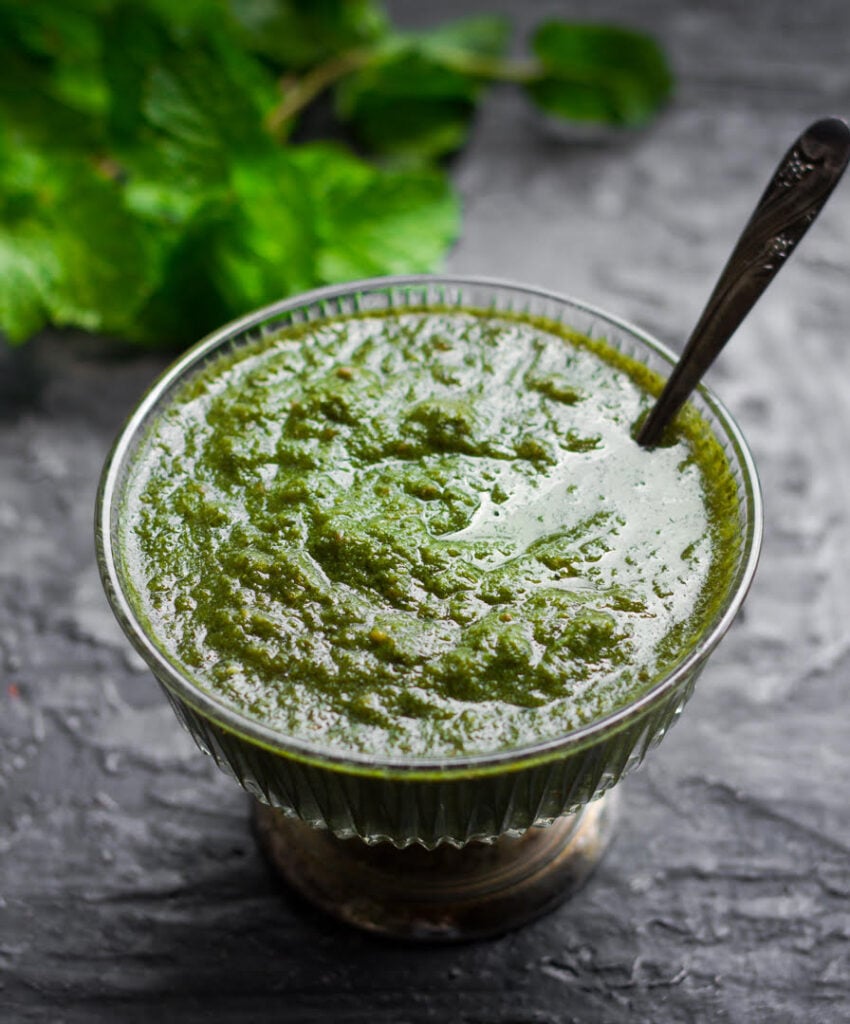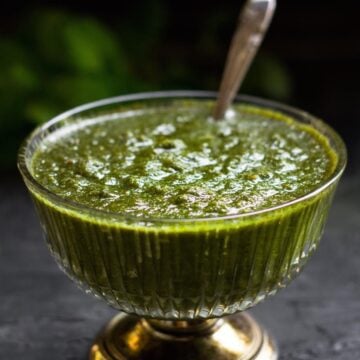The dishes that grace our table every day. The relishes that are woven into our meals. The condiments that are integral to our cuisine. We take them for granted.

“Oh, this I can whip up with my eyes closed and with no taste-test. Let’s skip it and make something new.” That’s the fleeting thought that crossed the mind, at least in mine.
Well, the jokes on me. What I take for granted is exotic and new for someone else and deserving of a full blog post. After all, the blog is as much my chronicles of cooking as it is for readers.
So, today I take a break from penning recipes that are new to me and dive into authentic pudina chutney, or as the rest of the world knows it – Mint Chutney.
For us, mint chutney is a pantry essential. There’s a jar of it in my fridge that I keep replenishing every few days. This year it’s a bit more special because I am only using homegrown mint. As somebody burdened with a brown thumb, I’m very proud of the bounty my kitchen garden has produced!
How to Make Mint Chutney?
At one time, chutney was made by grinding fresh ingredients on sil batta. That’s the Indian version of mortar and pestle. It took time and a lot of elbow grease. Thankfully for food processors, it takes mere minutes to whip mint chutney now.
You take mint, coriander or cilantro, green chilies, garlic, ginger, lemon juice, and tomato, throw it in a blender and churn till you have the desired consistency. I like to keep mint chutney on a finer side, but you can stop pulsing the ingredients a tad earlier if you want a textured, chunky chutney.

For such short work, the flavor of mint chutney is deceptively complex. While mint is the dominant touch, it has layers that burst forth with every morsel.
The cilantro gave it a brighter hue and mingled with garlic brings down the strong minty aroma. Ginger and lemon juice give it a palatable sharpness while the tomato adds a hint of tang. The chilies do the heavy work of providing it a fiery punch.
Quick notes:
There are two reasons mint chutney can taste bitter. One, you churned it for so long that the essential oils made it rancid. Two, you used mint stems.
The trick is to pluck the leaves and only add those. If you include mint stems, the chutney will not taste as good.
Do the exact opposite for the coriander/cilantro. The stems are more flavorful than the leaves. So, incorporate both of them.
Variations of mint chutney recipe:
As many homes there are in India, there are an equal number of chutney recipes. Some would be appalled that I add tomato to it, and some would vigorously nod their heads.
Here are some other variations you can try, till you get the taste you love. Though, quite frankly, all of them are deliciously spicy.
- You can add a half an onion to give mint chutney a thicker consistency. Fresh green onions work like a charm too.
- Skip the tomato and replace it with amla or Indian gooseberry, if they are in season.
- For those who have access to raw, green mangoes, do try it in mint chutney. Just remember not to add tomatoes.
- A touch of sugar helps you cover all your bases. The sweetness is sufficiently molecular that you don’t even notice it.
- Add yogurt to the chutney to make it extra creamy. This is the version most restaurants serve.
- Grated coconut is another prevalent variation.
When it comes to spiciness, let your personal preference rule the day. Add as many or little chilies as you like. My mint chutney is not too hot, but yes, it does have a spicy zing to it.
You can even play with dried spices. Both dried mango powder (amchur) and ground pomegranate seeds (anardana) will give the chutney a terrifically tangy taste.

Serving Mint Chutney:
There is a reason why chutneys are an essential component of Indian cuisine. They have a million, and one uses and turns even the blandest of meals into an epicurean pleasure.
You can serve mint chutney with absolutely everything.
Mint-flavored rice:
To a tempering of cumin and coriander powder, add cooked rice and then mix in mint chutney. Voila! In a few minutes, you have mint-flavored rice.
Mint raita:
Stir in some mint chutney in yogurt, add salt and roasted cumin powder, and in no time, you have refreshing raita ready.
Snacks:
No Indian snack is complete without a dollop of spicy, flavorsome mint chutney. But the fresh minty touch is the perfect accompaniment to fried foods like millet cutlets, besan ki katli, and samosas.

Once you’ve tried mint chutney in a Bombay sandwich, you will never look back. The combination is heaven on a plate. Chat, rolls, pita filling, kebabs, and more. You can pair mint chutney with endless things.
I leave you with a teaching that’s been passed down by my family. Mint chutney or any other, in fact, is not just a savior of meals. Yes, it is an added attraction to a plate, but it does so much more.
Mint is an excellent carminative herb. In chutney, it not only improves digestion but also soothes the stomach. Both cilantro and mint are glorious sources of Vitamin C. Mixed in chutney, they bring vitamin B, E, D, and K to the table.
What I’m trying to say is - mint chutney is a healthy, edible journey definitely worth taking!

I’d love to hear from you! Please tag me on Instagram @tashasartisanfoods, using the hashtag #tashasartisanfoods. You can also FOLLOW ME on INSTAGRAM, PINTEREST for more fabulous recipes!
📖 Recipe

Mint Chutney
Ingredients
- 1/2 cup Fresh Mint, leaves only
- 1/4 cup Fresh Cilantro/ Coriander, chopped
- 2-3 Green chilies You can add less or more, depending on your preference
- 2 small Tomatoes, chopped
- 4-5 cloves Garlic
- 1.5" Ginger
- 1-2 tsp Lemon juice
- Salt to taste
Instructions
- Blend everything in your blender or food processor until smooth.
- Taste and adjust for salt, spice and sourness level.
- Transfer to an air-tight jar and store in the refrigerator for 4-5 days.
Nutrition






Leave a Reply